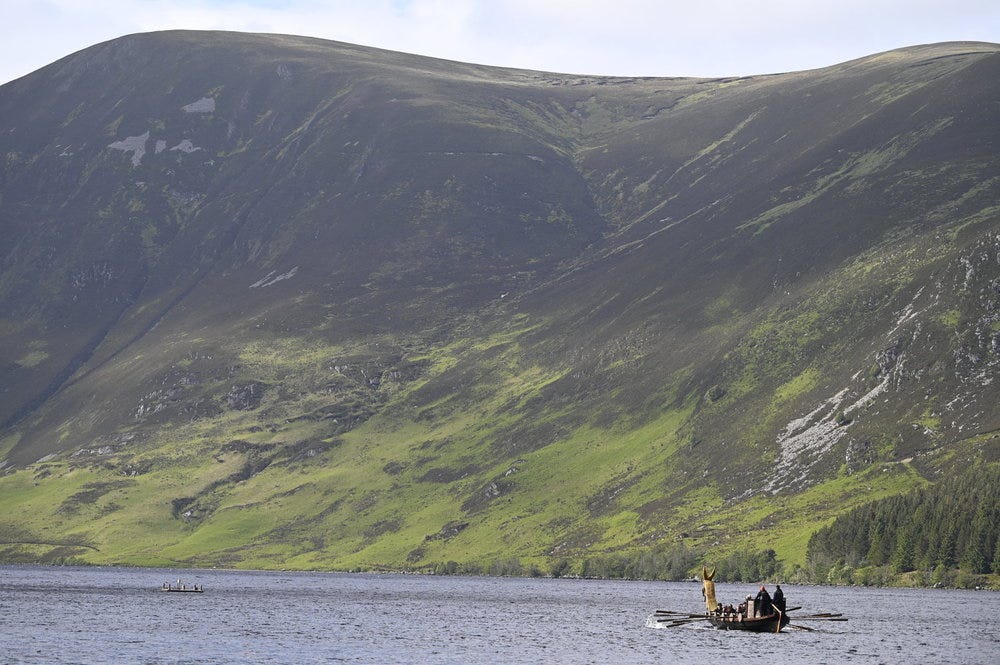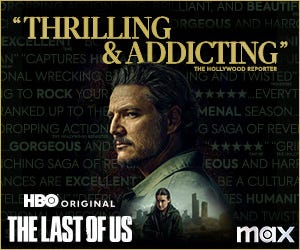Rachel Bloom’s Wild DIY Emmy Campaign: No Billboards, Just Belief
The Emmy winner's Netflix special wasn't submitted by the streamer, so she's taking matters into her own hands. Plus: Inside the craft of 'The Traitors'

Today, I’ve got a check-in from an Emmy winner who is running her own very unconventional awards campaign this time around, plus a deep dive into one of the most technically challenging sequences from my favorite reality show.
But first, I want to make sure you caught that you can now listen to some of the panels moderated by me and my colleagues Elaine Low and Lesley Goldberg at the DGA Theater in Los Angeles last month. On one special episode of The Ankler podcast, you can hear us talk about the art of directing on High Potential, What We Do in the Shadows and Hacks, while another episode features our conversations on Severance, The Pitt, Good American Family and Zero Day. It was a great crowd that allowed our subjects to delve deeply into their craft — thanks to everyone who joined us!
No Streamer Bucks? No Problem!
“Do I want to spend $30,000 on one billboard near my house so I can jack off to it every time I drive by? Yeah, it’s nice to plan it being like, ‘My enemies will be so upset.’ I don’t have that many enemies, but for the few I do have, that’s always nice. But it’s ultimately not worth it.”
That’s not, to put it mildly, what you would usually hear from someone campaigning for an Emmy, much less from someone who is paying for their Emmy campaign themselves. But it sure is refreshing to hear from Rachel Bloom, the actress and comedian leading the charge to submit her latest comedy special, Rachel Bloom: Death, Let Me Do My Special, for Emmy consideration without the support of the streamer that distributed it.
Death debuted on Netflix in October, but as part of the licensing deal Bloom struck with the company, an Emmy campaign was not included, as it was for other Netflix specials, signed under different deals, from the likes of Adam Sandler, Ali Wong and Jamie Foxx. Bloom wants to be clear that Netflix was an excellent partner for her special, and “This is not me kvetching at all.” But after her experience on Crazy Ex-Girlfriend, which did receive modest support from its network, The CW, for its awards campaigns, Bloom is very aware that awards attention can provide a meaningful lift.
“When we won the Emmy, I felt almost evil with joy,” Bloom remembers about her Emmy win, alongside the late Adam Schlesinger and Jack Dolgen, for the original song “Anti-Depressants Are So Not a Big Deal” from Crazy Ex-Girlfriend in 2019. “Award shows are weird, elevated work functions, but also when you get nominated or win, it feels fantastic.”

Bloom credits awards attention, which also included her Golden Globe win in 2016 for best actress in a comedy, for keeping Crazy Ex-Girlfriend on the air. The stakes are not quite the same for her one-off special, but Bloom is going for it anyway, participating in interviews like this one and posting about the special on her Instagram account (including resurfacing promotional appearances she did for Death, Let Me Do My Show when it was Off-Broadway, like this one with Seth Meyers). She’s also covering the Emmy submission fees not just for herself but for her crew in seven categories, in addition to outstanding writing for a variety special and outstanding variety special, for which she would be the nominee. Submission fees vary based on the number of entrants per category and come with discounts for Television Academy members. Still, the price starts at $125 per submission and goes from there.
Bloom’s main cost in all of this is paying her publicist and social media team, using the power of virality she learned way back in 2010 to get the word out about a deeply personal special. The show breaks its own format early on to become a little bit musical theater, a little bit of a debate with Death, and a lot of personal reflections on the birth of her daughter, the early days of Covid, and mortality itself. (Schlesinger, her longtime friend and creative partner, died in New York of complications from coronavirus days after Bloom’s daughter was born in Los Angeles.)
“I’m pretty confident saying there’s nothing like this,” Bloom says. “I’m proud of my live vocals, and also it manages to be wrapped in a narrative, wrapped in a one-act play. Ultimately, it is a comedy special, but I think, format-wise, there’s nothing else like it out there.”
Bloom isn’t the first person to take a run at an awards campaign on her own. Several Game of Thrones actors, including Gwendoline Christie, submitted themselves for Emmy consideration in 2019 and were rewarded with subsequent nominations. But consider: If Bloom manages to pull a Melissa Leo and upends the entire FYC system by skipping the traditional print ads and billboards, running her campaign her own way and getting a bunch of nominations? We might all benefit from that kind of upheaval — well, except for her enemies, of course.
The Traitors’ Aquatic Feat
I’ve spent a lot of time over the past few weeks within the world of The Traitors — or, at least, the best simulacrum of the world of The Traitors that the Peacock awards team can provide for Emmy voters and press within Los Angeles city limits. You may remember the Chateau Marmont brunch in May, where our own Richard Rushfield was revealed as a dastardly traitor. There was also an afternoon drag show at The Abbey just ahead of West Hollywood Pride, complete with a booty-shaking contest judged by season 3 contestant Bob the Drag Queen. It was all as fabulous and surreal as it sounds (watch below).
However, none of it provided me with real insight into how The Traitors, one of the few true breakout reality show hits in recent years, comes together during its Scotland production. For that, I had to reconvene a group I had first spoken to last summer to reveal the production secrets behind The Traitors and just how much of the drama and gamesmanship we see on screen is playing out in real life. This time, I focused on the challenge in the first episode, in which 20 newly assembled contestants had to cooperate to row an enormous boat across a long Scottish loch. It probably already sounds like a logistical headache — and I haven’t even told you about the 35 cameras yet.

Each episode of The Traitors puts the contestants through a distinctive challenge, be it solving puzzles or enduring having bugs dumped on their heads. For the first episode, says producer Sam Rees-Jones, a recurring theme has emerged: “The loch has become synonymous with those episode one missions, and some element of fire has become a little bit synonymous as well.”
With the third season of the U.S. edition, though, the producers wanted to thread the challenges more completely in with the rest of the series, which the contestants mostly spend whispering and scheming against each other in the castle. The challenges allow the contestants to win some kind of benefit, usually a shield that will prevent them from being “murdered” by the traitors, but the real secret to success in The Traitors is always playing the social game. Winning a shield won’t mean anything if your actions during the challenge convince your fellow contestants to turn against you and vote you out.
That’s where the true genius of the boat challenge comes into play. Not only are the 22 contestants asked to cooperate to row the boat, but they are also stopped at a series of way stations and asked to leave behind two people to get more money for the collective prize fund. Those people, then, become ineligible for the shield. But, as happened with Real Housewives star, they can also build suspicion that they are traitors themselves.
“We wanted to make the players and the viewers go, ‘Okay, the actions and decisions they make in the missions will have consequences,’’ Rees-Jones explains. “What better way to start than the players ultimately creating a murder shortlist — that felt like a really good, compelling narrative to start with.”
The human drama of the boat challenge is what makes it sing; an early series high was watching Bob the Drag Queen and Danielle Reyes volunteer to stay behind on a raft, neither of them knowing yet that the other was a traitor. But with 22 contestants on the boat and all the real forces of nature to contend with, capturing all those bits of drama — plus host Alan Cumming on the shore, commenting on the whole thing — takes basically a literal army to pull off.
“It had to be one of the biggest challenges we’d ever done,” says Ben Archard, who has directed more than 40 episodes of The Traitors across both the UK and American versions. “I think the course was about five kilometers, we had 35 cameras in total on it, and we pretty much did it in one take. I always say it’s a shame we don’t have a camera on what’s actually happening behind the scenes. The people running around in the background, scurrying to make things work— it’s incredible to see it unfold on the ground.”

Director of photography Matt Wright was charged with rigging the old, Viking-style boat with 15 remote-operated cameras, plus a spot for a camera operator to hide on board as well. That was in addition to two camera boats, long-lens cameras on the shore, and even a handful of drones. “The distance that the players rowed is massive, and to have that constant coverage just enabled the story to be told,” says Wright. “There are four pontoons, and there’s a dilemma at each pontoon. You start to see people’s different motives and different thought processes, and you’re just always gathering that story.”
Fellow director of photography Siggi Rosen-Rawlings, meanwhile, was on duty up at the castle, capturing the arrival of all the contestants that morning and then the fallout from the boat challenge and roundtable elimination that evening. Yes, Rosen-Rawlings says, everything really is happening in a day, just like they say on the show. “It’s in real time, and that’s part of us creating this immersive bubble that we need to keep the players in,” he explains. “That’s important to the show.”
“There’s a real dance that goes on,” adds Rees-Jones, explaining that sometimes the cast will beat members of the camera crew back to the castle after a challenge, requiring constant communication among the departments. “The amount of times that I’ll go to Ben and then Ben will talk to Siggi and Matt and say, ‘Look, we don’t want to stop, we don’t want to cut, we don’t want to have redos— how do we achieve this?’ The guys will always look at ways of making it happen to make sure that it’s an immersive experience of the players first and foremost.”
Rees-Jones ends with a dramatic understatement that surely anyone in this business can relate to: “Television is not easy.”












